Latest observations added at the top.
Images taken with 5inch or 6inch APO refractor or 12inch CDK or 13inch Newtonian
Recording with DMK41 or ASI120MC / ASI174 with FireCapture. Processing in AstroStakkert!3, Registax 6 and Photoshop CS2.
2020-12-20 to 2020-12-23 (UT) The great planetary conjunction of Jupiter and Saturn was a great sight to observe and record. Visually from a day before to after the conjunction the planets could easily fit into the same high magnification eyepiece and show detailed views. The closeness to the horizon meant that a single still image will have some detail deterioration due to seeing. The table below shows the progression of the conjunction around the time of closest approach. Click on image for larger size.
Time |
130mm F6.3 APO refractor, Canon 600D with 2x TeleVue barlow |
130mm F6.3 APO refractor, ASI120MC, 10%/1000Frames |
| 2020-12-23 01:19UT | 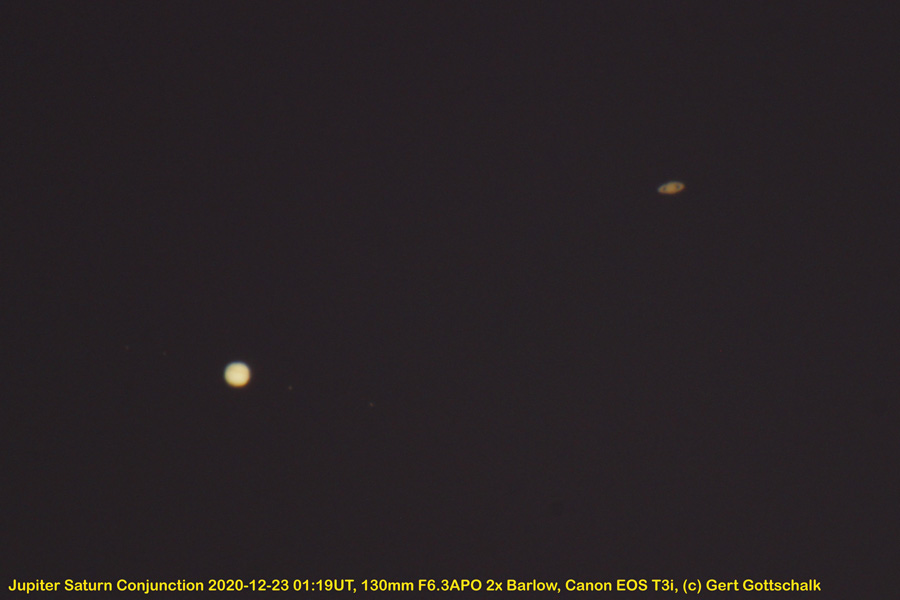 |
|
| 2020-12-22 01:21UT | 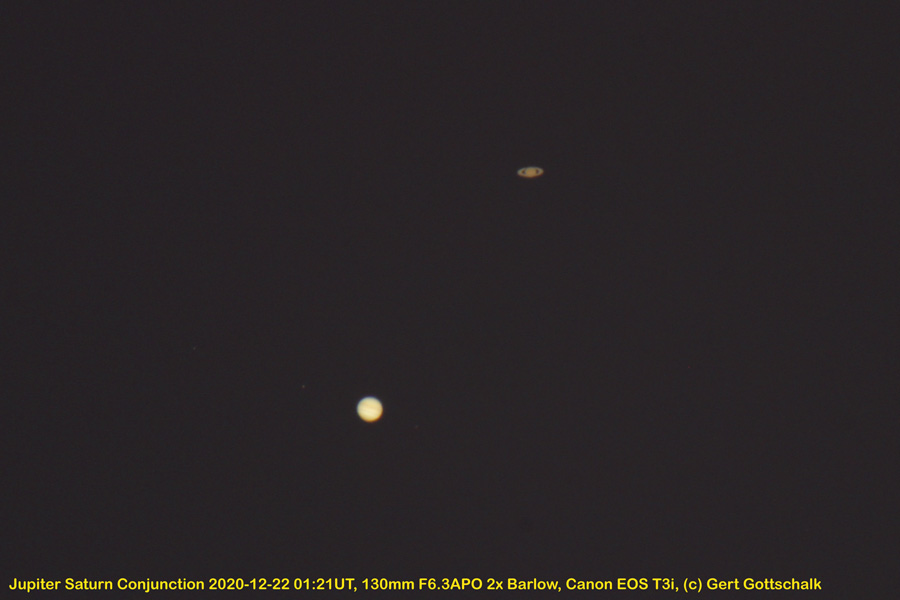 |
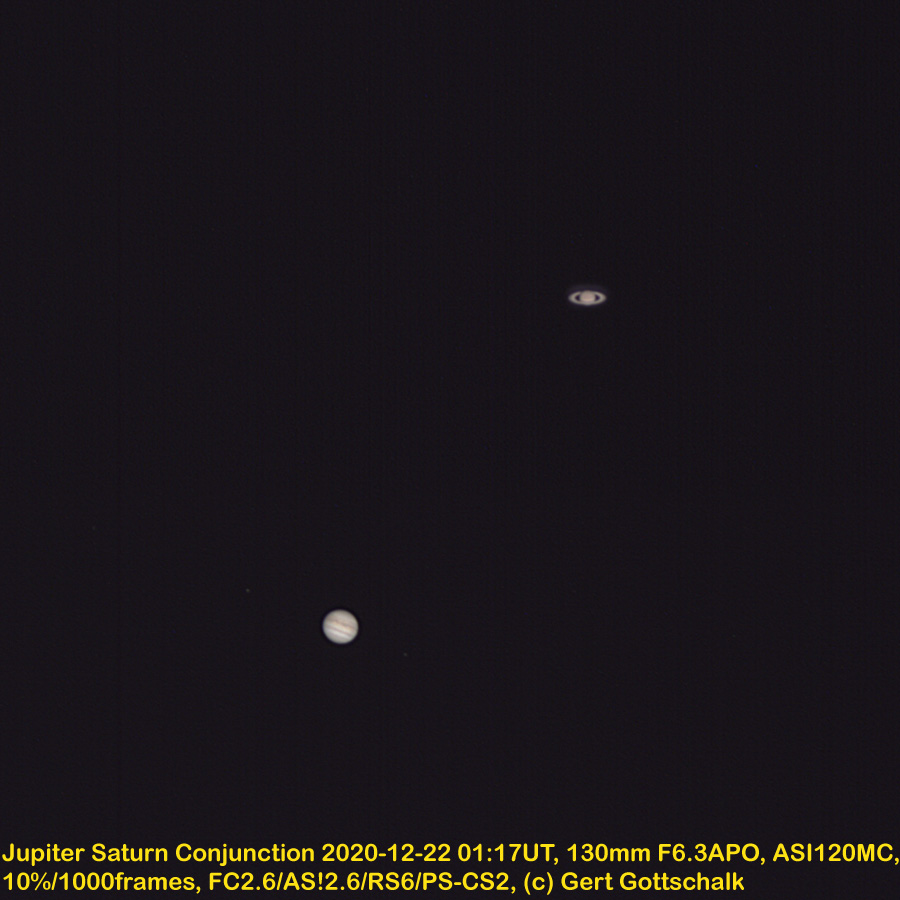 |
| 2020-12-21 01:23UT | 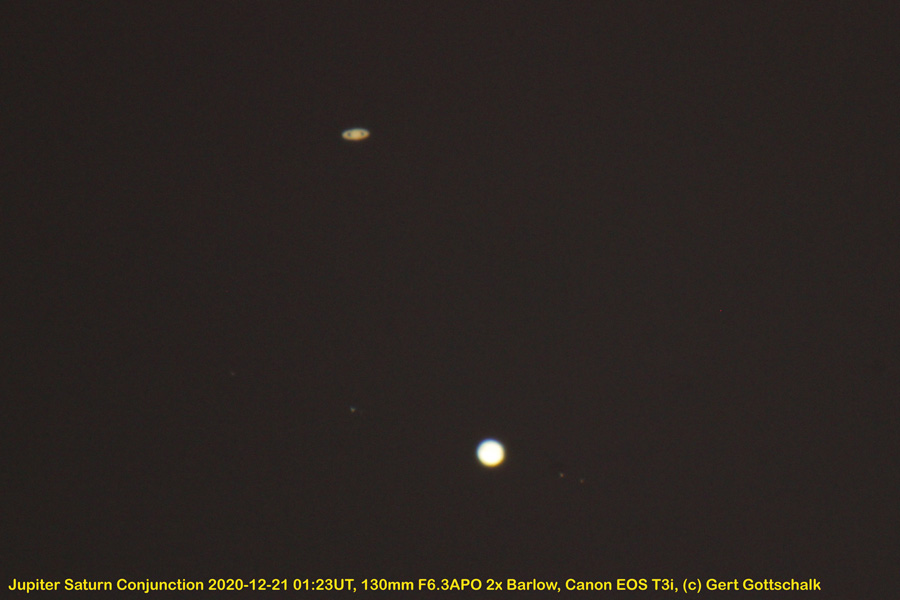 |
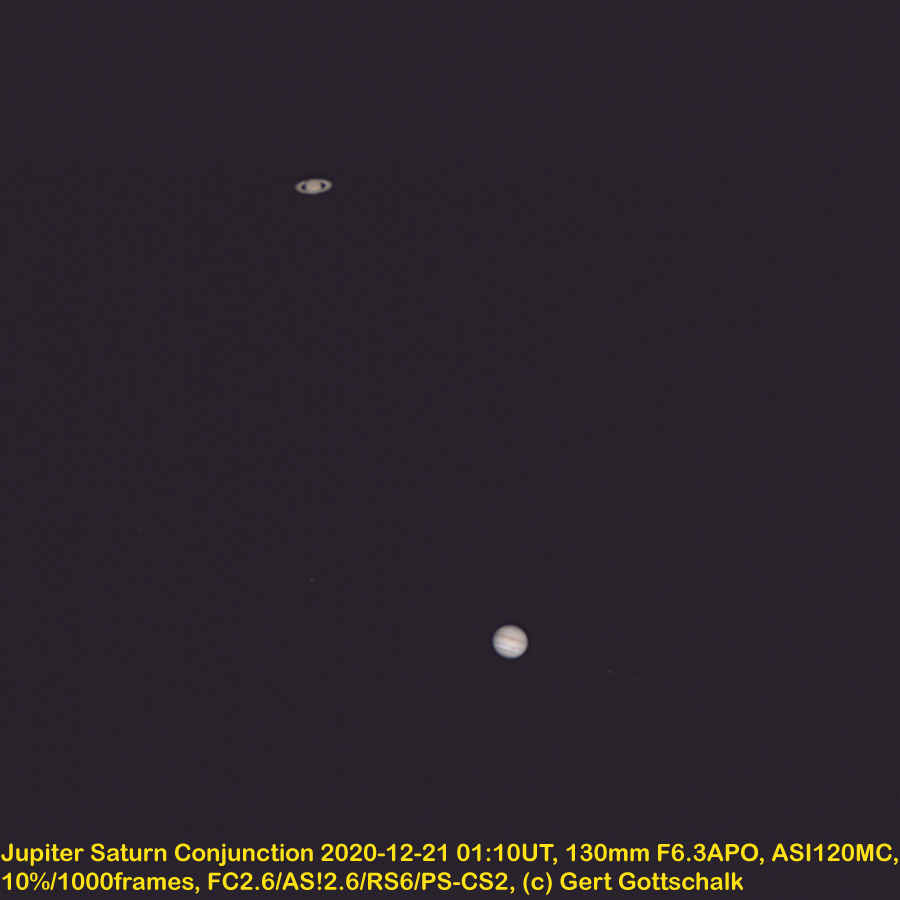 |
| 2020-12-20 01:27UT | 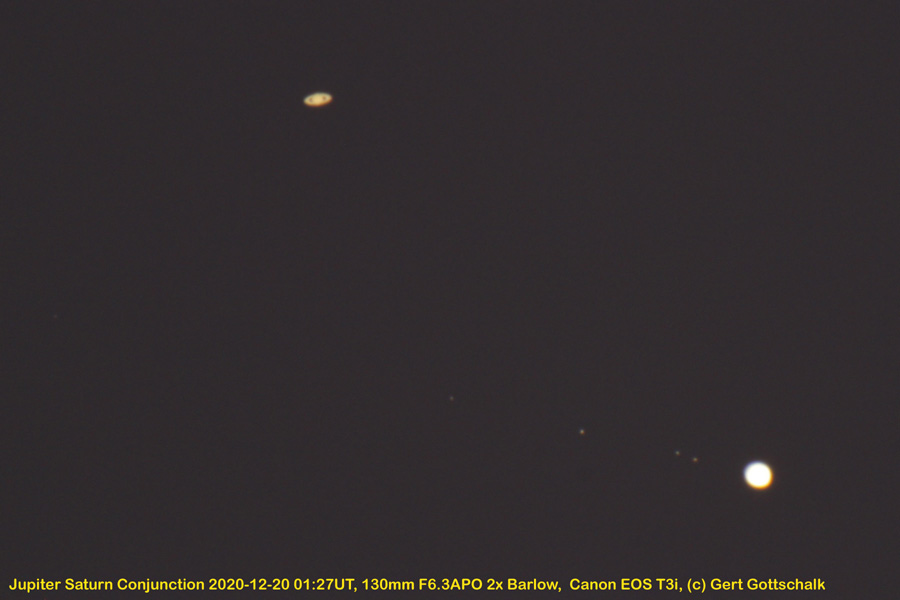 |
2020-10-18 to 2020-11-15. More Mars images obtained over several days with same equipment and processing. Mars has a rotation period of 24:37. so only after a few days the visible face of Mars changes when observing at the same time of evening. Amazing how significantly the size of the planet's disk is changing as time is now past opposition.
| 2020-11-15 04-33UT | 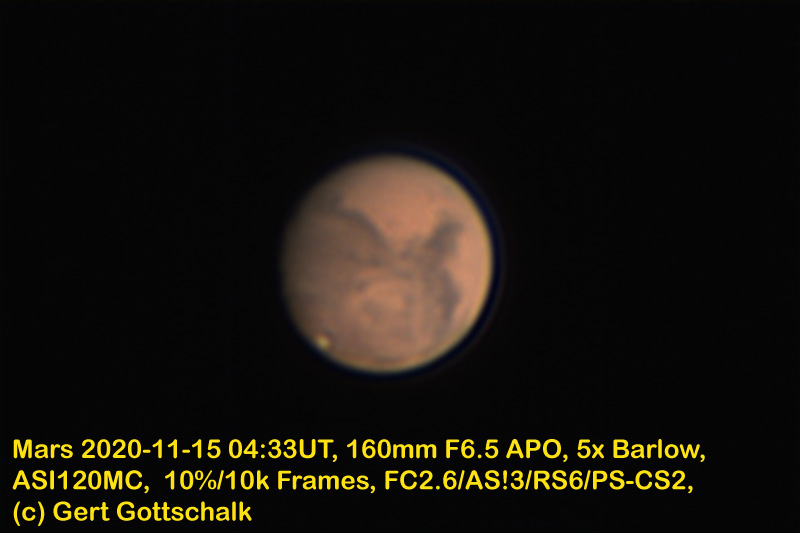 |
|
| 2020-11-05 05:20UT | 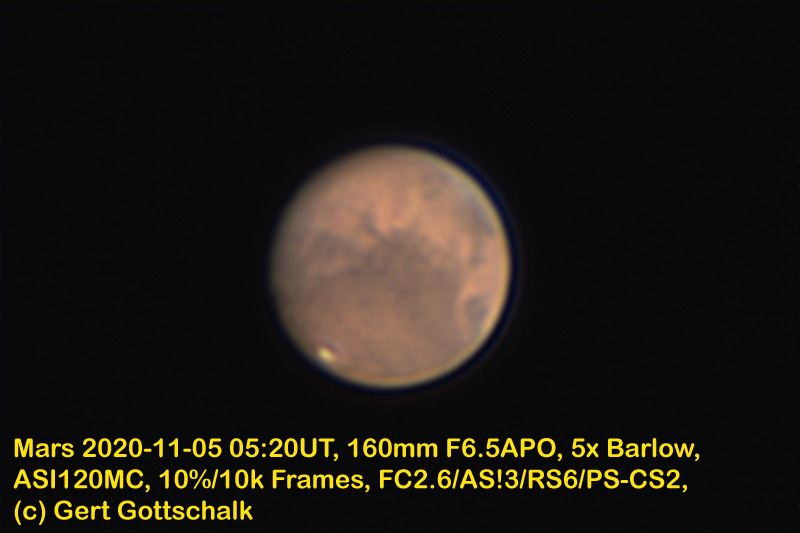 |
|
| 2020-11-01 05:06UT | 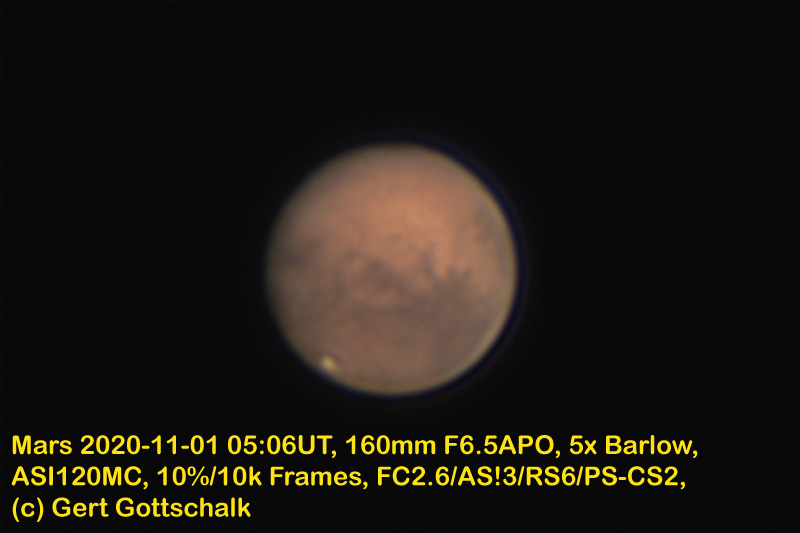 |
|
| 2020-10-28 05:39UT | 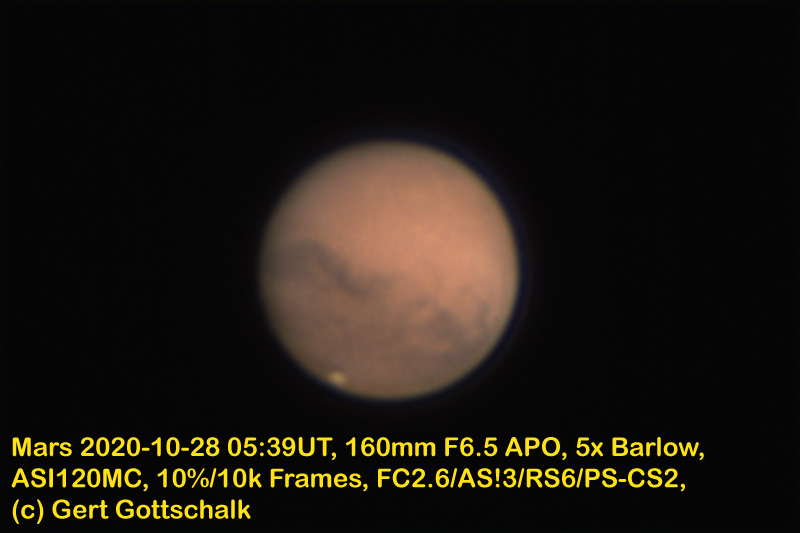 |
|
| 2020-10-20 06:08UT | 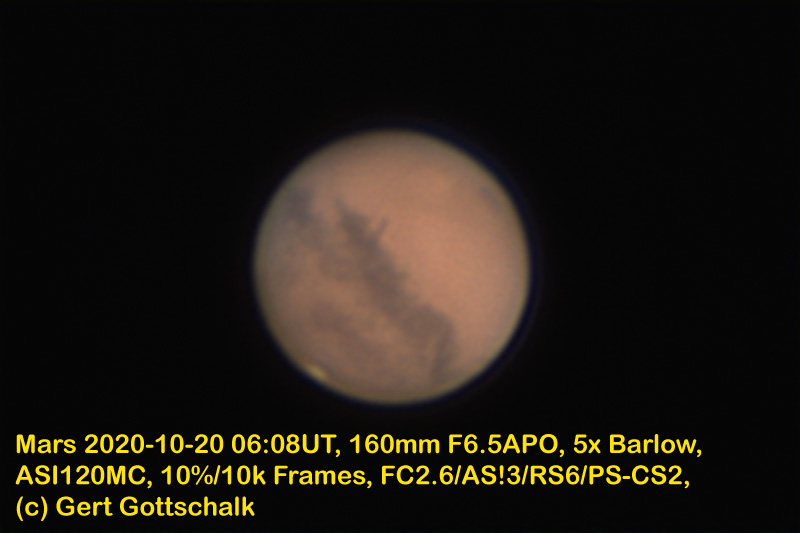 |
|
| 2020-10-19 06:22UT | 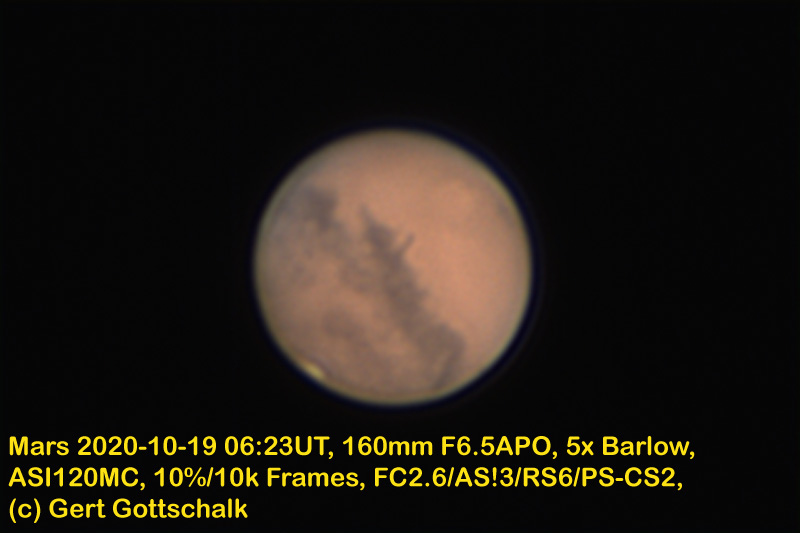 |
|
| 2020-10-18 06:14UT | 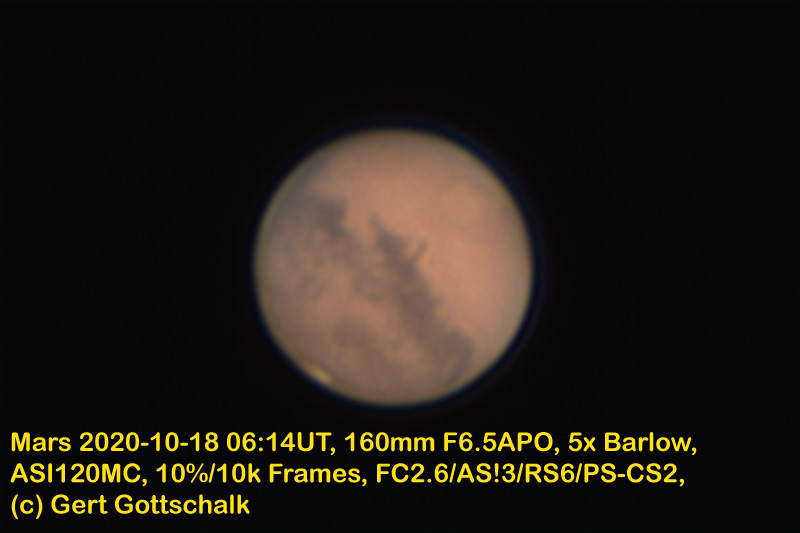 |
2020-10-14 06:40UT. The day of the Mars opposition. I wanted to try how a smaller aperture might be less affected by seeing issues. So the 14inch SCT was replaced by 160mm refractor. I think the view go better contrast. Again the best single image is shown and then all images were combined into a time lapse. The quality was more evenly distributed in this session. All images were of good quality making the animation less variable.
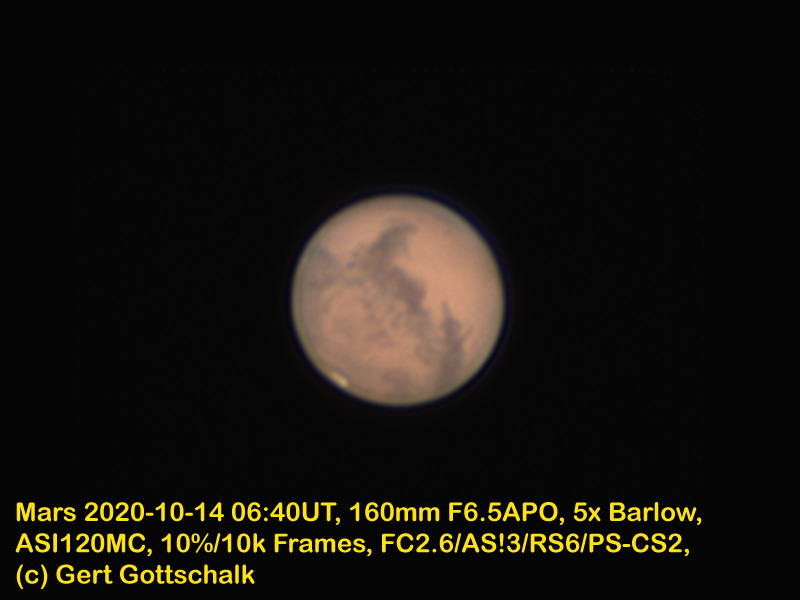 |
2020-10-04 08:16UT. The image size of Mars is changing this time not because it is coming so much closer to Earth, but because changing from 1.8x Barlow to 2.5x Barlow. I wanted to have some more image scale from the F11 focal ratio of the SCT. After midnight there were some good seeing conditions and a good amount of detail was seen on Mars visually and in the videos. I had recorded just a small number of videos and no intention to have a larger time lapse. But in the end there was some Rotation visible in the images and I combined them into a short time laps animation.
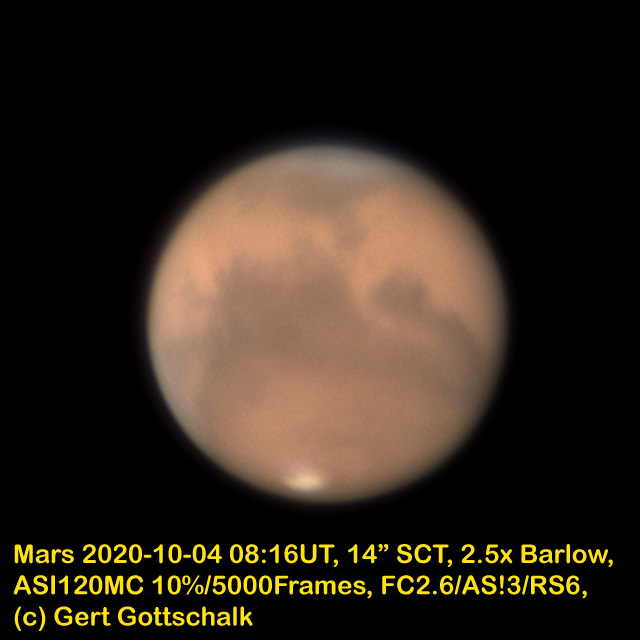 |
2020-09-25 08:18UT. This is the first image of Mars at this 2020 opposition. The planet has a good elevation and during good seeing a lot of detail is visible. At the time of the image the disk had an angular diameter of 22.08arcsec. The SCT has F11 so only the 1.8x barlow was used. Visually the planet is very bright and with 14inches aperture magnification up to 440x could be used.
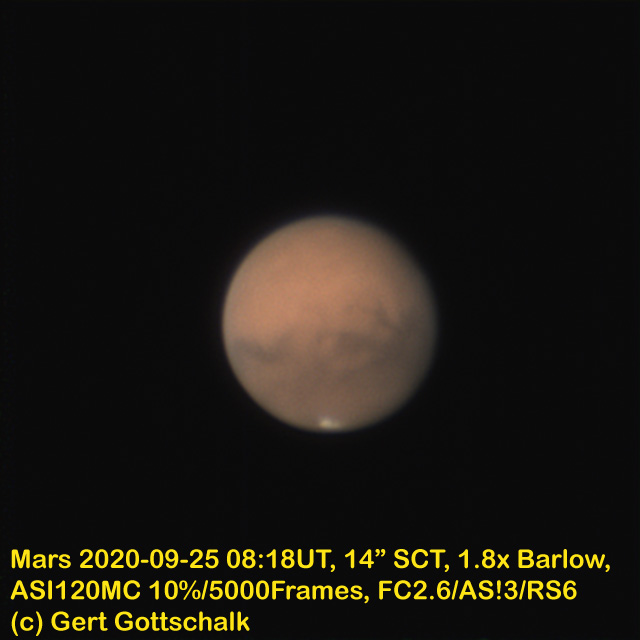
2020-09-06 03:40UT Jupiter / 04:50UT Saturn. Unfortunately so far there were no successful imaging sessions for the gas giants planets Jupiter and Saturn. Last weekend finally the conditions were right and the telescope ready. The seeing turned out to be OK for urban conditions from my balcony. In the images the same optical and camera setup was used, so the planets are shown at their relative scales. Saturn is almost 2x farther away than Jupiter and the ring system (as seen) is much larger than Jupiters disk.
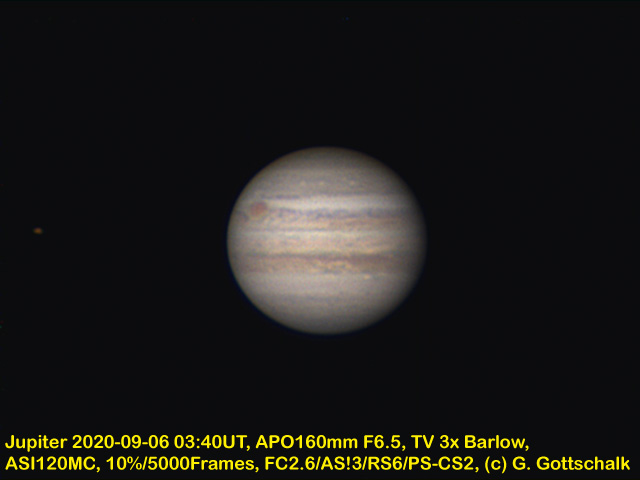 |
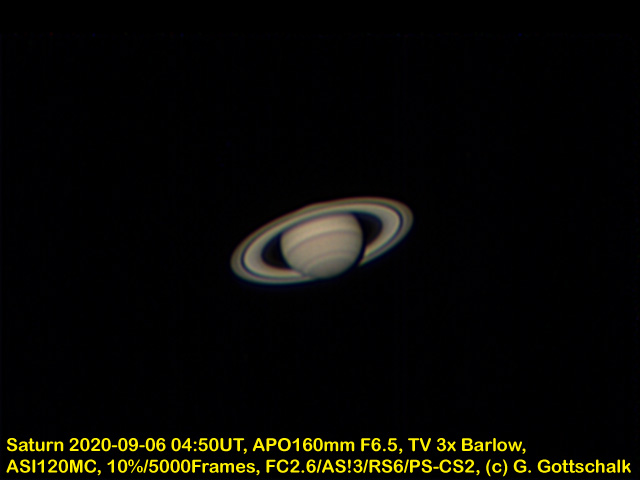 |
2020-05-24 06:05UT. The crescent Moon joins Mercury and Venus with Venus having moved away from mercury and closer to the Sun.
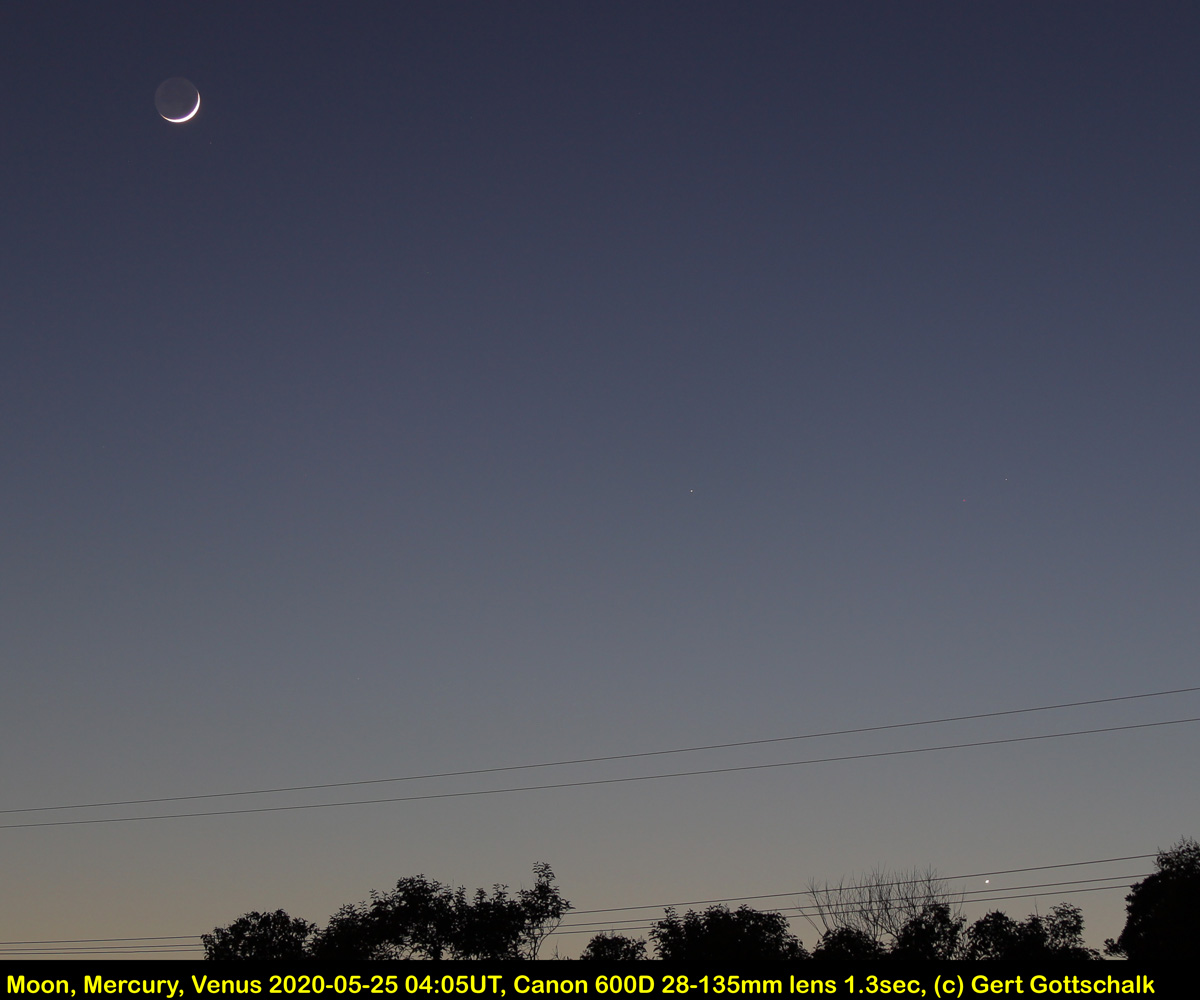
2020-05-23 19:46UT. Just another chance before Venus is lost in the Sun's glare. The daytime seeing was a bit better on this day than on the previous attempt and we can see the thin crescent even better defined. The other inner planet mercury was nearby and in the same imaging session I recorded multiple AVIs. The images shown below are at same pixel scale and demonstrate how large the Venus crescent was. Further below a hand held image of the two planets in the evening twilight..
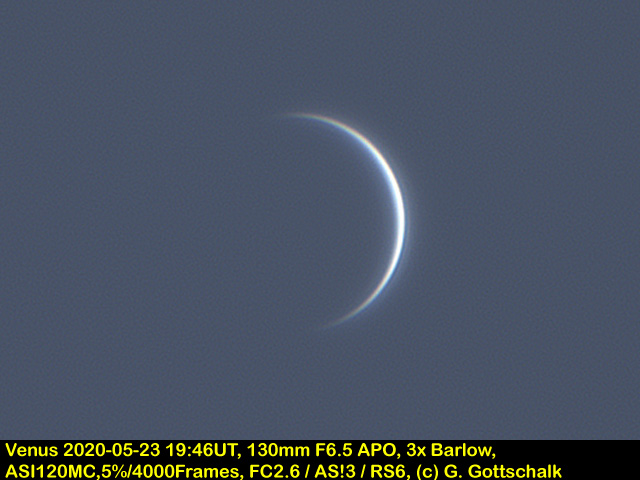 |
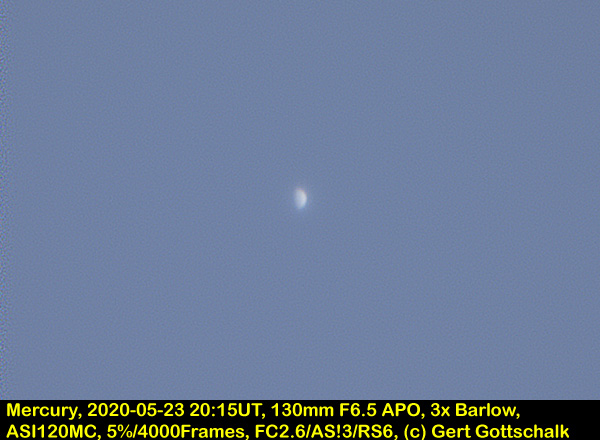 |
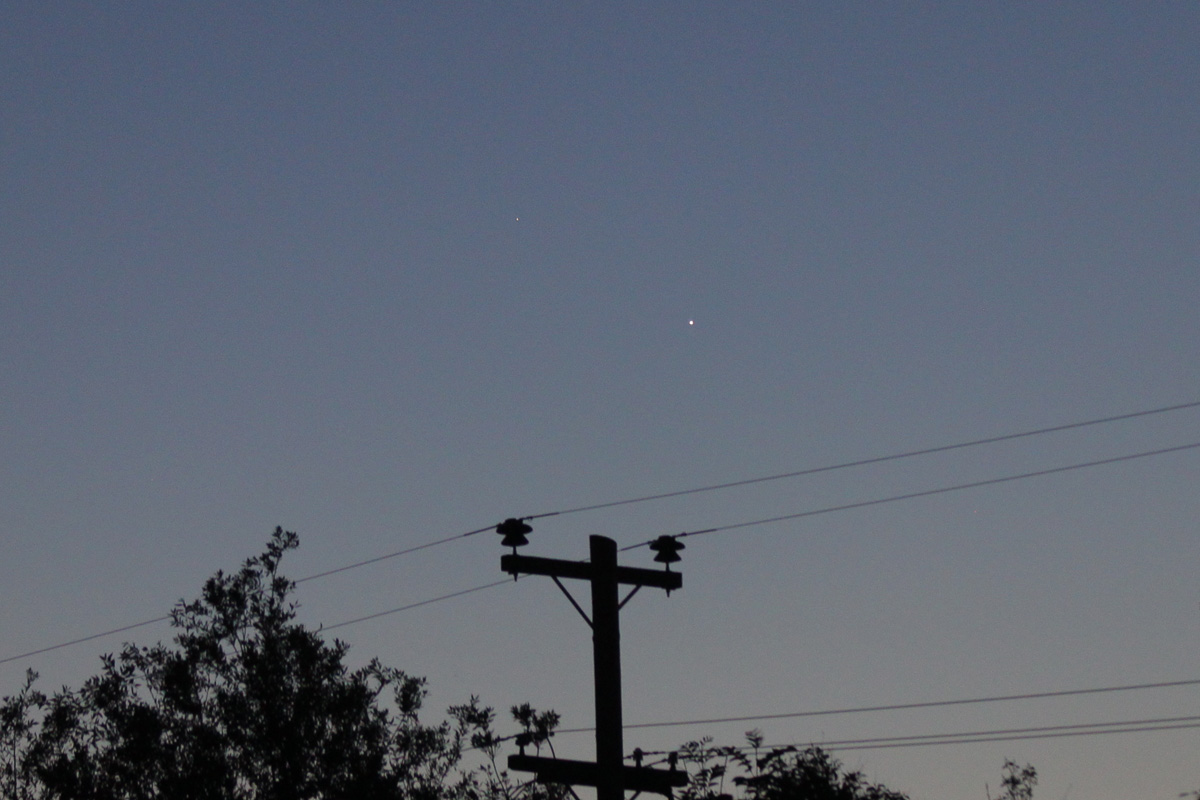
2020-05-21 20:25UT. The planet Venus is ending its evening visibility and is heading for inferior conjunction, the position between the Sun and the Earth. Just now Venus has a very thin but large crescent. This image was recorded with the ASI120MC on the 130mm refractor. Processing uses 5% of 4000 Frames . Software used FC2.5 / AS!3.0 / PS CS2.
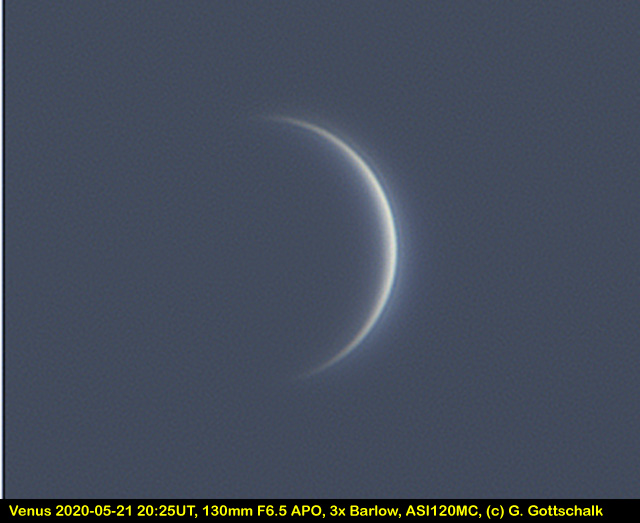
2020-01-23 01:24UT & 01:30UT. The first observation of 2020 is also introducing a new imaging filter. The image on the left is the first experiment with an Optolong Venus-UV filter (passing UV-A light 320nm-400nm). Using the 12inch CDK and TeleVue 2.5x barlow the system transmission in UV is heavily reduced via glass absorption. Exposure 33ms and gain 400 make for a quite noisy image. There is also a ghost reflection and it's origin still has to be investigated. But there is a hint of the clouds structure on Venus! On the right a comparison in visible light. This one had exposure 2.3ms and gain 100. But besides the phase it shows no other features.
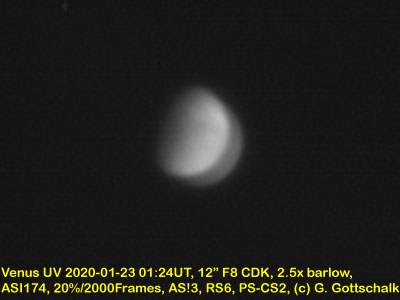 |
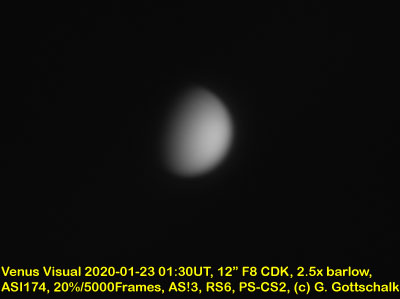 |
Copyright images and processing Gert Gottschalk.
Copyright Bilder und Verarbeitung Gert Gottschalk